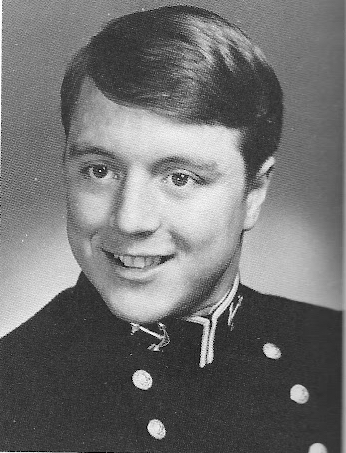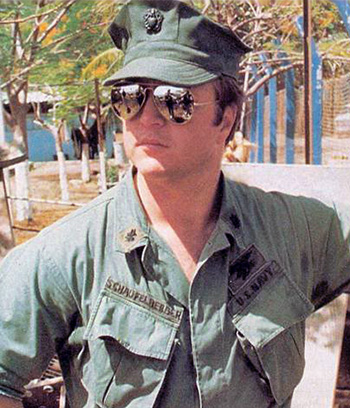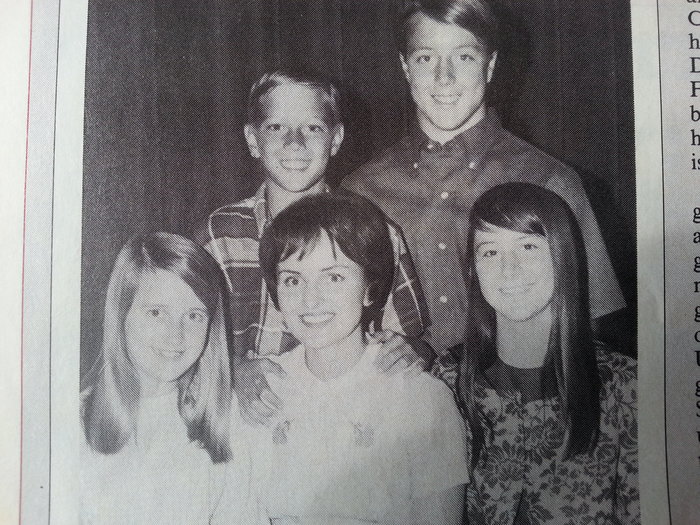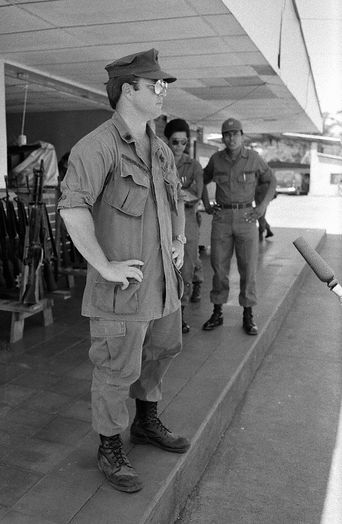ALBERT A. SCHAUFELBERGER, III, LCDR, USN
Albert Schaufelberger, III '71
Lucky Bag
From the 1971 Lucky Bag:
ALBERT ARTHUR SCHAUFELBERGER
Better known as "Schauf," Al distinguished himself throughout this four years at the Academy as one of the striking personalities of the company. From the stages of amateurish plebe, to the rebellious youngster year, and finally the mellow last year, Schauf found himself constantly striving to make the Academy more bearable, to the amusement of his classmates. No one will ever forget the great "Sandal Scandal," the renowned "HogAnna," his Porsche streaking down the Indianapolis 50, or his angelic smile which captivated the hearts of "Many" a young maiden. He will make a great success of himself in whatever he pursues.

ALBERT ARTHUR SCHAUFELBERGER
Better known as "Schauf," Al distinguished himself throughout this four years at the Academy as one of the striking personalities of the company. From the stages of amateurish plebe, to the rebellious youngster year, and finally the mellow last year, Schauf found himself constantly striving to make the Academy more bearable, to the amusement of his classmates. No one will ever forget the great "Sandal Scandal," the renowned "HogAnna," his Porsche streaking down the Indianapolis 50, or his angelic smile which captivated the hearts of "Many" a young maiden. He will make a great success of himself in whatever he pursues.
Career
From Veteran Tributes:
Al Schaufelberger was born on August 8, 1949, in Annapolis, Maryland. He entered the U.S. Naval Academy on June 28, 1967, and was commissioned an Ensign in the U.S. Navy on June 9, 1971. ENS Schaufelberger next attended Basic Underwater Demolition/SEAL (BUD/S) training with Class 65 at NAB Coronado, California, from August 1971 to March 1972, followed by service with Underwater Demolition Team TWELVE from March 1972 to June 1975. During this time he served on the recovery crew for the SKYLAB III mission in September 1973, and Operation Frequent Wind in South Vietnam in April 1975. LT Schaufelberger's next assignment was as the Swimmer Delivery Vehicle (SDV) Platoon Commander with SEAL Team ONE at NAB Coronado from June 1975 to November 1976, and then as an SDV Instructor with BUD/S training at NAB Coronado from November 1976 to January 1979. He served as an Ordnance Officer, Platoon Commander, SEAL WESTPAC Detachment Commander, and Operations Officer with SEAL Team ONE at Coronado from January 1979 to February 1981, and then attended the Spanish Language Course at the Defense Language Institute in Monterey, California, from February 1981 to February 1982. After additional training, LCDR Schaufelberger served as Senior U.S. Naval Representative at the U.S. Military Group, El Salvador, and as Security Chief for the American military advisors in El Salvador from August 1982 until he was assassinated by insurgents at the Central American University in San Salvador on May 25, 1983. Per his instructions, his remains were cremated and his ashes were scattered in the Pacific Ocean from a Navy SEAL Patrol Boat off of Coronado Island.
Obituary
From People magazine on June 13, 1983:
One day in 1967 young Albert Schaufelberger heard his name ring out over the public-address system at Lemoore High School in Kings County, Calif. Wild with worry, he thought the summons to the principal’s office meant that his namesake father, a Navy pilot, had been shot down in Vietnam. The school was near the Lemoore Naval Air Station, and friends had received similar calls. Instead, the honor-student senior learned that he had been awarded a college math scholarship. Recalls his mother, Virginia, “He was so relieved he didn’t even care about the scholarship.”
Two weeks ago, however, when the phone rang at the Fripp Island, S.C. home of Albert’s father—who after three tours had returned safely from Vietnam in 1969 with a chestful of medals including the Bronze Star—the news was tragic. His eldest son, Navy Lt. Comdr. Albert Schaufelberger III, 33, security chief for the American military advisers to El Salvador and the second highest-ranking U.S. officer in that country, had been shot to death—a murder later attributed to leftist guerrillas. He was the first U.S. serviceman killed there since American soldiers began training government troops in 1980.
His death had about it that combination of horror and the mundane that has come to characterize El Salvador’s simmering revolution. While waiting to pick up his girlfriend, Consuelo Escalante, 32, outside Central American University, where she is manager of a cooperative store, he was shot three times in the head by a gunman. Schaufelberger’s body was returned to the U.S. Memorial Day weekend. In accordance with sealed instructions he left before going to El Salvador, his ashes were to be scattered in the Pacific from a patrol boat belonging to Navy’s elite SEALs.
(Two days after the killing President Reagan, apparently signaling his commitment to an even harder line against El Salvador’s guerrillas, relieved Assistant Secretary of State for Inter-American Affairs Thomas O. Enders and indicated that America’s ambassador to the beleaguered country, Deane R. Hinton, would be replaced.)
Himself a member of the SEALs, highly trained in sea, air and land combat, Schaufelberger believed deeply in his training mission, and some saw his murder as evidence of his success at interdicting arms smuggled to leftist guerrillas by sea. Others saw it as a grim reminder of the beginnings of U.S. involvement in Vietnam. Not his family. “Vietnam is a wrong analogy,” says his father, Albert, 56. “For the moment it seems to me to be a reasoned approach to help out a nation that is genuinely striving for democracy.”
As Schaufelberger’s brother, Tom, 28, a Richmond, Va. attorney, and two sisters, Kristine, 30, an immigration supervisor, and Margaret, 32, a San Diego detective, gathered with their parents at Fripp Island, near Charleston, S.C., there were many happy memories of Al, and cruel silences as well. “He was hard-driving, very determined,” remembers Tom. Margaret adds, “If he decided he wanted to do something, he was meticulous and did an outstanding job.” His family recalled the way he plunged into woodworking as a hobby at age 30. “His first project wasn’t a set of bookends,” says his father. “It was a seven-foot executive desk, made of solid teak, and the thing’s a damn beauty.”
After high school, where he excelled academically (with a reported IQ of 155) and athletically (“He was small but he wasn’t afraid of anything,” remembers a football teammate), he entered Annapolis, a goal since age 12. The 5’9″ cadet lettered in 150-pound football and lacrosse before graduating in 1971. His drive carried him into training for the SEALs, which have a dropout rate of some 75 percent. Not Schaufelberger. He once fell 30 feet from a cargo net on an obstacle course. Badly injured, he crawled through the course until an instructor put a foot on his back to stop him.
His Navy assignments took him to Japan, Thailand, the Philippines and Korea, but home was the modest three-bedroom house he bought in a San Diego suburb. There he coached a boys’ soccer team, built a redwood hot tub, and worked on his VW camper. He became a gourmet cook, sometimes preparing dinner for 30 friends, and let his siblings use the house when they wanted. “Al was a big brother in every sense of the word,” says Margaret.
In his final absence, Schaufelberger’s military family choked back their tears, but didn’t disguise how proud they had been of the officer they had known as a man and a boy. “Oh yes. Tremendously proud,” says his mother. “He was a wonderful son. A wonderful brother. We couldn’t have asked for more happiness, and we’re thankful for the 33 years we had.”
From the September 1983 issue of Shipmate:
LCdr. Albert Arthur Schaufelberger USN was killed in the service of his country on 25 May 1983 in San Salvador, El Salvador. Memorial services were held in San Salvador and at Fripp Island, South Carolina, before a final requiem at the Base Chapel, Naval Amphibious Base, Coronado, California. At his request his ashes were scattered at sea off San Diego on 3 June.
The son of a career naval officer, LCdr. Schaufelberger was born in Annapolis and was graduated from the Naval Academy with the Class of 1971, whereupon he was ordered to basic underwater demolition training at the amphibious school in Coronado. He later had duty with Underwater Demolition Team Twelve, then was assigned to Seal Team One.
After having taken an intensive course in the Spanish language he reported to duty with the United States Military Group in El Salvador in August of 1982 and was the second ranking officer of the American military advisers to El Salvador's armed forces. He was murdered as he awaited in his car for a friend at the University of Central America. While in El Salvador he had been responsible for the training of Navy personnel in the eastern city of La Union as well as for the security of the advisory group. He was a member of the Naval Academy Alumni Association.
He is survived by his parents, Capt. and Mrs. Albert A. Schaufelberger Jr. USN (Ret.) '49, of Fripp Island, South Carolina; a brother and two sisters.
LCdr. Schaufelberger was particularly fond of Shakespeare's Hamlet and drew strength from the moving words of Horatio to his dying friend Hamlet, considered by many to be the most beautiful lines in all of Shakespeare; "Now cracks a noble heart. Good night, sweet Prince, And flights of angels sing thee to thy rest. "
Albert's name is on the killed in action panel in the front of Memorial Hall under heading "El Salvador 1983."
Wikipedia Entry
From his wikipedia entry:
Albert Arthur Schaufelberger (August 8, 1949 - May 25, 1983) was a Lieutenant Commander in the United States Navy who was assassinated in El Salvador.
Background
Schaufelberger was a graduate of the United States Naval Academy at Annapolis, Maryland and was an avid (150 lb) American football and lacrosse player while in college. His father, Albert Arthur Schaufelberger (Senior), was a decorated fighter and bomber pilot during the Vietnam War.Role in El Salvador
Lieutenant Commander Schaufelberger was the senior U.S. Naval representative at the U.S. Military Group, El Salvador. He was a United States Navy SEAL, second in command of the U.S. Military Group advising the Salvadoran Military on counter insurgency and weapons traffic interdiction operations. In addition, he was security chief for the 53 U.S. military advisors in the country at the time. Schaufelberger had responsibility, among other duties, for naval operations in the Gulf of Fonseca which were run out of the La Union naval base. It was at the La Union naval base where Schaufelberger allowed himself to be photographed for the last time several days before his assassination. Schaufelberger's death was the first of a U.S. military member in El Salvador following the October 1980 arrival in country of U.S. military advisors.Assassination
At approximately 6:30 pm on May 25, 1983, Schaufelberger was assassinated on the grounds of the Central American University in San Salvador. A group under the umbrella of the Farabundo Marti National Liberation Front (FMLN), the Central American Revolutionary Workers' Party (PRTC), is thought to have carried out the act.Schaufelberger had been dating an employee of the university, Consuelo Escalante Aguilera, for several months and often drove to the university in civilian clothes to pick her up after work. On May 25 he arrived and sounded the horn of his armored embassy-provided Ford Maverick, his signal to inform his date that he had arrived. Ms. Aguilera exited her office and observed what she believed to be a white Volkswagen microbus pull up and stop near Schaufelberger's car. Reportedly several individuals were involved with the assassination, with at least one firing through the open window of Schaufelberger's car. Schaufelberger's car leaped forward, impacting a car directly in front of it. The assassins then jumped into their vehicle and escaped. Unfortunately for him, Schaufelberger had removed the bullet-resistant glass over the driver's-side window after the air conditioner in his vehicle had broken.
Schaufelberger saw his role in El Salvador of preventing a communist takeover of the country for all of the people of El Salvador—not just those of means. He realized, however, that he might be a target of the insurgents, given the success of the weapon interdiction efforts. During his last discussion with journalists covering U.S.-advised Salvadoran military operations, Schaufelberger told those present that the insurgents "know who I am, and where I live". His house had apparently already received drive-by gunfire on a recent evening prior to the assassination.
Press coverage
Albert Schaufelberger's assassination was featured on the front cover of the June 6, 1983 edition of Newsweek magazine. The U.S. edition was headlined The First Casualty and the international edition Shooting to Kill.Schaufelberger was photographed in uniform and interviewed by international media representatives (including Newsweek) one week before his death. Previous pictures of Schaufelberger had been taken by the Magnum Photo Agency in Paris for a syndicated feature story on the escalating U.S. military involvement in the region. For security reasons Schaufelberger appeared in those photos as a rear view only and in civilian clothes.
Photographs

The "category" links below lead to lists of related Honorees; use them to explore further the service and sacrifice of alumni in Memorial Hall.


